What is Brickmold on a Door? It's More Than Just Fancy Trim
Author: Rick Worst | Editor: Omar Alonso
Review & Research: Jen Worst & Chris Miller
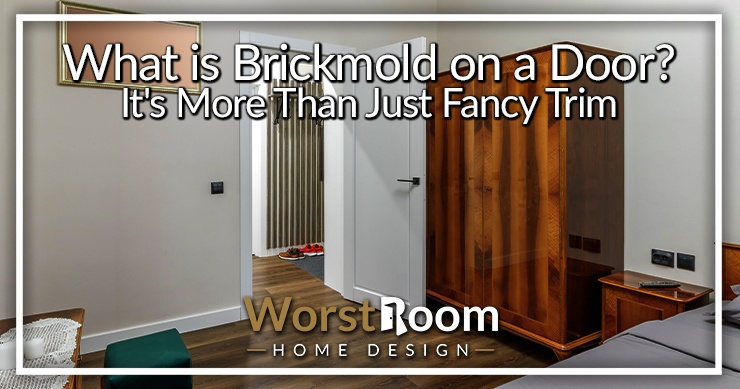
When it comes to doors, many components work together to create a functional and aesthetically pleasing entryway. One such part that plays a role in a door's appearance and functionality is brickmold. You may have encountered this term before and wondered, what is brickmold on a door, and why is it important?
In this article, we’ll dive into the world of brickmold on a door, exploring its purpose, different types, installation process, and maintenance considerations.
Understanding Brickmold on a Door
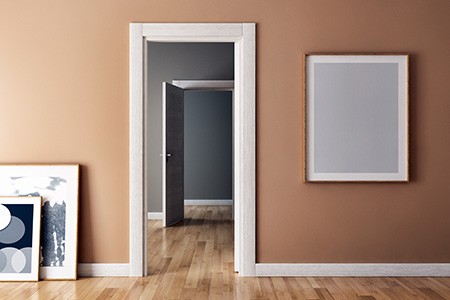
Brickmold is a vital element in constructing and designing doors and windows for residential and commercial buildings. It serves as exterior trim and finishes, seals, and protects the openings surrounding exterior doors and windows. You would not use this on any types of interior doors.
This casing creates a barrier between a structure's siding or facing material and the door or window frames.
The purpose of brickmold extends beyond practicality to aesthetics as well. It enhances curb appeal by providing an attractive transition from exterior siding materials—such as bricks, stone veneer, or stucco—to your home's entryway or window frames.
Furthermore, it allows homeowners and builders to choose from different styles that complement their overarching architectural design elements while adding durability to their exteriors.
Materials Used for Brickmold
Selecting the right material for brickmold is essential, as it plays a crucial role in protecting and enhancing the appearance of your door. Various materials are available on the market, each with unique characteristics and benefits.
Finger-joint pine is an affordable option that provides a natural wood look while being more stable than solid wood due to its engineered structure. However, it requires regular maintenance, like painting or sealing, to prevent rot and insect damage. With painting, you can try to mix and match colors, at least, like making the storm door match the front door or the brickmold or not.
Composite PVC brickmold has gained popularity for its durability and resistance to rot and insects without sacrificing the strength found in traditional wood trims. This can be attributed to their poly fiber composition, making them low-maintenance choices.
Vinyl is another durable, low-maintenance option that resists moisture, insects, warping, or cracking over time while still adding visual appeal around your exterior doors.
Aluminum brickmold is lightweight, strong, and resistant to rust and corrosion, making it suitable for exterior doors exposed to harsh weather conditions. It’s available in different finishes and is relatively low-maintenance, offering good longevity.
Choosing an appropriate material for your brickmold depends on factors such as aesthetics preference, budget constraints, environmental exposure conditions of your home's location, and the desired maintenance levels you're willing to commit to maintaining them over time.
Types of Brickmold Styles
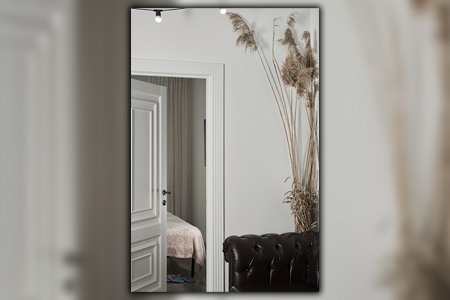
We know what is brickmold on a door, but what about the available styles? Brickmold styles come in various designs, materials, and sizes to suit architectural aesthetics and preferences. Materials used for brickmold include finger joint pine, composite, vinyl, or stain grain wood.
Styles vary from traditional options such as plain flat casings to more intricate designs featuring decorative details like fluting, rosettes, or beading. These styles can enhance the visual appeal of your exterior door while providing a seamless transition between the door frame and adjacent wall surfaces.
Here are two main brickmold types discussed below:
Traditional Brickmold
Traditional brickmold is a common type of trim used around doors and windows. It’s typically made of wood and features a simple, rectangular profile.
The main purpose of traditional brickmold is to provide a clean transition between the door frame and the surrounding wall. It creates a visually pleasing border and helps protect the door from the elements.
Traditional brickmold usually has a rectangular cross-section with straight edges and corners. It extends beyond the door frame and creates a visual border around the door. This type is typically wider and thicker than other types of trim.
Traditional brickmold is versatile and can be used in various architectural styles, including colonial, craftsman, and traditional homes. It’s commonly found on exterior doors, such as front entry doors, side doors, and back doors.
However, they can also be used on interior doors, especially in spaces where a more substantial and decorative trim is desired.
Integrated Brickmold
Integrated brickmold, integral brickmold, or built-in brickmold, is a newer type of door trim that combines the brickmold and door frame into a single unit. Unlike traditional brickmold, which is installed separately, integrated brickmold is factory-applied and integrated into the door during the manufacturing process.
It's convenient as it eliminates the need for separate brickmold and door frame installation. It provides a seamless and streamlined appearance, enhancing the overall aesthetics of the door. It also ensures precise alignment between the door and the trim, minimizing gaps and potential water infiltration.
Compared to traditional brickmold doors, integrated doors are easier to install since they're already attached to the door. They're also more durable, reducing the risk of separation or damage between the brickmold and door frame. It has a sleeker, modern look, with no visible joints or seams between the door frame and brickmold.
However, they offer less room for customization since the integrated backmold is manufactured as part of the doorframe.
The availability of different finishes allows homeowners to further customize their selection by matching it with existing trim work or other elements on their property.
Benefits of Brickmold on a Door
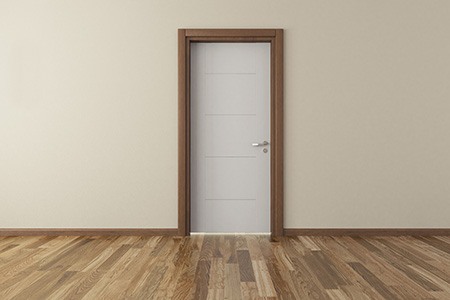
What is brickmold on a door and what are the benefits of using it? Brickmold, as an essential component of a door, offers a range of benefits beyond its aesthetic appeal, providing functionality, protection, and architectural cohesion to your entryway.
Aesthetic Appeal & Curb Appeal
Brickmold on a door enhances a home's aesthetic and curb appeal. Brickmold serves as a casing around exterior doors and windows, adding architectural detailing that can make an ordinary entryway look more elegant and sophisticated.
It creates a boundary between the wall and the door frame, providing a finished look that ties together all design elements.
Protection Against Water Infiltration
Brickmold on a door helps protect your home against water infiltration. The trim's design creates a barrier that deflects water away from the doorframe and prevents it from seeping into the interior of your house.
Another layer of waterproofing comes from sealing mull posts with plastic mull boots. These components keep water out while maintaining proper ventilation between windowpanes, preventing any unwanted moisture buildup that could cause further damage.
Energy Efficiency
The seal created by the brickmold trim helps to create an additional barrier against drafts, ultimately reducing heat loss in colder months and keeping cool air inside when it's hot outside.
This can lead to long-term savings on your energy bills, as you won't need to rely on heating or cooling systems quite so much. For example, if you have a wooden front door without brickmold that isn't properly sealed, you may lose up to 10% of your home's heating energy during winter.
Increased Security & Durability
Brickmold helps reinforce the door frame, making it more difficult for intruders to break in.
Moreover, exterior doors are subject to wear and tear due to exposure to harsh weather elements such as rain, snow, heat, and frost. However, with brickmold installed around your door casing, you can protect it from this kind of damage while also enhancing its overall durability.
Easy Installation & Replacement
Brickmold is relatively easy to install, making it a convenient option for builders, contractors, and homeowners. It can be fitted and secured around the door frame using nails or screws.
If damaged, brickmold can also be replaced without extensive modifications to the door or frame. This flexibility simplifies maintenance and repairs, saving time and effort. What is brickmold on a door if not easy to install!
Installing & Maintaining Brickmold on a Door
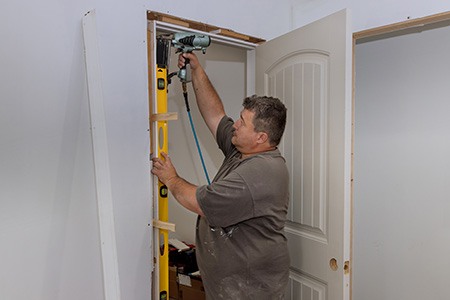
To install and maintain brickmold on a door, you’ll need some essential tools, including a saw, drill, hammer, and level.
Properly installing and maintaining brickmold on a door is crucial for achieving seamless integration and ensuring its long-lasting performance as a vital trim element.
Preparation & Tools Required
Before installing brickmold on a door, several tools and materials are required for the job. These include rosettes and corner blocks, a saw, hammer, nails or screws, wood glue or caulk, measuring tape, and a level.
When cutting brickmold to size, you must measure accurately to ensure a proper fit around the door frame. Rosettes and corner blocks can be used as decorative elements at the corners of the brickmold trim.
Once all pieces have been cut and prepared accordingly, they can be secured onto the door with either nails or screws.
Proper preparation and use of necessary tools ensure that your newly installed brickmold provides not only an aesthetic appeal but also protection against weather elements while increasing energy efficiency and overall security level.
Step-by-Step Installation Instructions
Proper installation requires a basic understanding of carpentry principles, safety measures, and the right tools.
After selecting the appropriate material for your brickmold trim, you'll want to prepare the surface of the doorframe by removing any debris or old paint. You'll then need to cut each piece of brickmold down to size using a table saw or circular saw before attaching it with screws or nails.
Once installed, it's essential to maintain your brickmold trim by regularly cleaning it with soap and water and inspecting it for damage caused by weather conditions or insects.
Common Challenges During Installation
Installing brickmold on a door may present certain challenges, such as those discussed below:
- Uneven Walls: If the walls surrounding the door are not perfectly straight, it may cause difficulties in aligning the brickmold. To overcome this, use shims or adjust the placement of the brickmold to achieve a level and even appearance.
- Moisture Management: Properly sealing the gaps between the brickmold and the door frame is essential to prevent water infiltration. Use weather-resistant caulk or sealant and ensure a tight seal during installation.
- Matching Trim Styles: When installing brickmold as a replacement or for additional doors in an existing building, it can be challenging to match the current trim styles. Consider consulting a professional or using custom millwork services to create a seamless match in such cases.
Brickmold Cleaning & Maintenance Tips

Regular cleaning and maintenance can go a long way to ensure your brickmold on a door remains in top shape. Begin by inspecting the brickmold around your exterior doors quarterly to assess any damages or signs of wear and tear.
Use a soft brush or cloth to remove dust, dirt, and debris from the surface of the brickmold. For tougher stains, a mild detergent mixed with water can be used. Avoid using abrasive cleaners or tools that may scratch or damage the surface of the brickmold. After cleaning, rinse with clean water and wipe dry.
If you notice any cracks or splits on the brickmold or the jamb surrounding it when you're maintaining them, address it immediately before more damage occurs. If left unchecked, these could expose the underlying wood to moisture, leading to rotting away at it over time.
Excessive exposure to moisture and sunlight can deteriorate the condition of the brickmold over time. Consider installing an overhang, awning, or porch to shield the door and brickmold from harsh weather conditions.
Applying a clear protective coating or UV-resistant paint can also help safeguard the brickmold from sun damage.
If the damage to your brickmold is too severe, a skilled carpenter or door specialist can assess its condition and provide expert advice. They can also perform necessary repairs or replacements to ensure the optimal performance and longevity of the brickmold.
Brickmold Replacement Options
If your brickmold is damaged or worn out beyond repair, you may need to replace it. Various replacement options are available depending on the type of exterior door and your budget.
PVC brickmold has become a popular choice among homeowners as it’s maintenance-free and can replace wood prone to wear and tear. Alternatively, you could opt for a new wood brickmold that matches the existing style if you want to maintain a traditional look.
So, What is Brickmold on a Door?
It comes in various materials, such as poly fiber composite and PVC, and creates an aesthetic finish around exterior doors and windows. Additionally, brickmold can help improve energy efficiency in your home by providing insulation.
Regular maintenance practices, such as cleaning, inspecting for damage, repairs, sealing, and protection from moisture and sunlight, help to preserve the appearance and functionality of the brickmold over time.
So, what is brickmold on a door? Brickmold on a door is an important exterior trim that protects the door frame from water infiltration and provides added security and durability.



